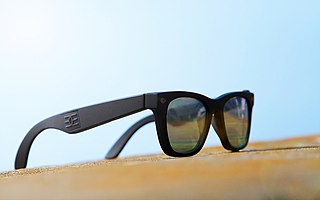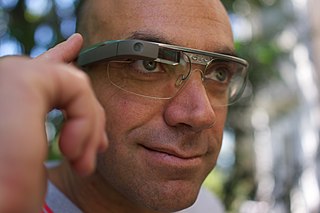| LyteShot logo | |
| Initial release | 2015 |
|---|---|
| Operating system | Android, iOS |
| Website | www |
LyteShot was an interactive augmented reality gaming platform. [1] [2] [3]
| LyteShot logo | |
| Initial release | 2015 |
|---|---|
| Operating system | Android, iOS |
| Website | www |
LyteShot was an interactive augmented reality gaming platform. [1] [2] [3]
LyteShot used augmented reality with mobile phones and augmented reality smartglasses for interactive gameplay. The website is down, and the last update was in 2016, although Twitter and Facebook accounts still exist. The platform integrated sensor-based hardware which wirelessly connects to users’ mobile devices and with the Internet of Things (IoT) to share in-game data via the cloud. The platform's sensor-based peripherals connect with mobile phones to bring multi-player digital alternate reality game or first-person shooter gameplay into the real world [4] [5] which adds digital components to live-action games. [6]
LyteShot platform consists of three core components to the system: a handheld device, called a "Lyter"; [4] [7] a receiver, called a "LytePuck", [4] [7] worn by each player; and LyteShot-enabled game applications on users' Bluetooth Low Energy-enabled smartphones operating on either iOS or Android. [2] [8] [9] [10] The Lyter, LytePuck, and mobile smartphone game apps connect to the cloud via Bluetooth enabling the transmission of game data for types of live action role-playing games, thus eliminating the need for referees or gamekeepers. [2] [8] Various peripherals, representing weapons and/or tools such as a gun or a sword, have also been developed to attach to the "Lyter" while gaming, [2] [9] [11] and users can also create their own attachments through design and 3D printing. [2] [9] [12]
LyteShot's first game release is Assassin: The Game, a first-person shooter based on the live action game of the same name. [2] [13] [5] [14] [15] [16] Developers can utilize the platform's software developer kit (SDK) allowing independent users to develop their own games for use with LyteShot's hardware and mobile technology. [1] [2] [4] [10] [12]
LyteShot was named as a Consumer Electronics Show (CES) Innovation Design Award honoree in the Gaming Hardware and Accessories category. [8] [17] In addition, LLteShot received Game Connections's international award for Most Original/ Creative Project as well as the Auggie Award from Augmented World Expo (AWE) for Best Game. [18] LyteShot debuted the platform at CES 2015, with Epson as a featured developer for the Epson Moverio BT-200 Smartglasses. [19]
The LyteShot company was founded in December 2012 [20] by CEO Mark Ladd, an architect and specialist in 3D data visualization; and David Brooks, a mechanical engineer who left the company in 2013. Tom Ketola, a veteran of game development at companies such as Activision and Disney Interactive Studios served as CTO from May 2014 until April 2015.; [7] [8] [21] The company is headquartered in Chicago, Illinois. [13] [14] [22]

A wearable computer, also known as a body-borne computer, is a computing device worn on the body. The definition of 'wearable computer' may be narrow or broad, extending to smartphones or even ordinary wristwatches.

Augmented reality (AR) is an interactive experience that combines the real world and computer-generated content. The content can span multiple sensory modalities, including visual, auditory, haptic, somatosensory and olfactory. AR can be defined as a system that incorporates three basic features: a combination of real and virtual worlds, real-time interaction, and accurate 3D registration of virtual and real objects. The overlaid sensory information can be constructive, or destructive. This experience is seamlessly interwoven with the physical world such that it is perceived as an immersive aspect of the real environment. In this way, augmented reality alters one's ongoing perception of a real-world environment, whereas virtual reality completely replaces the user's real-world environment with a simulated one.

A mobile game, or smartphone game, is a video game that is typically played on a mobile phone. The term also refers to all games that are played on any portable device, including from mobile phone, tablet, PDA to handheld game console, portable media player or graphing calculator, with and without network availability. The earliest known game on a mobile phone was a Tetris variant on the Hagenuk MT-2000 device from 1994.

Device Manager is a component of the Microsoft Windows operating system. It allows users to view and control the hardware attached to the computer. When a piece of hardware is not working, the offending hardware is highlighted for the user to deal with. The list of hardware can be sorted by various criteria.

A smartwatch is a wearable computer in the form of a watch; modern smartwatches provide a local touchscreen interface for daily use, while an associated smartphone app provides management and telemetry, such as long-term biomonitoring. While early models could perform basic tasks such as calculations, digital time telling, translations, and game-playing, smartwatches released since 2015 have more general functionality closer to smartphones, including mobile apps, a mobile operating system, and WiFi/Bluetooth connectivity. Some smartwatches function as portable media players, with FM radio and playback of digital audio and video files via a Bluetooth headset. Some models, called watch phones, have mobile cellular functionality such as making telephone calls.

Recon Instruments was a Canadian technology company that produced smartglasses and wearable displays marketed by the company as "heads-up displays" for sports. Recon's products delivered live activity metrics, GPS maps, and notifications directly to the user's eye. Recon's first heads-up display offering was released commercially in October 2010, roughly a year and a half before Google introduced Google Glass.

Epiphany Eyewear are smartglasses developed by Vergence Labs. The glasses record video stored within the glasses' hardware for live-stream upload to a computer or social media. The glasses use smartphone technology. The head mounted display is a mobile computer and a high-definition camera. The glasses take photographic images, record or stream video to a smartphone or computer tablet.

Tango was an augmented reality computing platform, developed and authored by the Advanced Technology and Projects (ATAP), a skunkworks division of Google. It used computer vision to enable mobile devices, such as smartphones and tablets, to detect their position relative to the world around them without using GPS or other external signals. This allowed application developers to create user experiences that include indoor navigation, 3D mapping, physical space measurement, environmental recognition, augmented reality, and windows into a virtual world.

Smartglasses or smart glasses are eye or head-worn wearable computers that offer useful capabilities to the user. Many smartglasses include displays that add information alongside or to what the wearer sees. Alternatively, smartglasses are sometimes defined as glasses that are able to change their optical properties, such as smart sunglasses that are programmed to change tint by electronic means. Alternatively, smartglasses are sometimes defined as glasses that include headphone functionality.

castAR was a Palo Alto–based technology startup company founded in March 2013 by Jeri Ellsworth and Rick Johnson. Its first product was to be the castAR, a pair of augmented reality and virtual reality glasses. castAR was a founding member of the nonprofit Immersive Technology Alliance.

Windows Mixed Reality (WMR) is a discontinued platform by Microsoft which provides augmented reality and virtual reality experiences with compatible head-mounted displays.

Microsoft HoloLens is an augmented reality (AR)/mixed reality (MR) headset developed and manufactured by Microsoft. HoloLens runs the Windows Mixed Reality platform under the Windows 10 operating system. Some of the positional tracking technology used in HoloLens can trace its lineage to the Microsoft Kinect, an accessory for Microsoft's Xbox 360 and Xbox One game consoles that was introduced in 2010.

Steam Link is a hardware and software product developed by Valve Corporation for streaming Steam content from a personal computer or Steam Machine wirelessly to a mobile device or other monitor. Steam Link was originally released as a hardware device alongside the debut of Steam Machines in November 2015. Valve discontinued the Steam Link hardware device in November 2018, in favor of supporting its software-based Steam Link application for mobile devices and smart televisions, as well as providing Steam Link as a software package for the Raspberry Pi microcomputer.

Spectacles are smartglasses dedicated to recording video for the Snapchat service. This term is often used to address sunglasses and eyeglasses. They feature a camera lens and are capable of recording short video segments and syncing with a smartphone to upload to the user's online account. They were developed and manufactured by Snap Inc., and announced on September 23, 2016. The smartglasses were released on November 10, 2016. They are made for Snap's image messaging and multimedia platform, Snapchat, and were initially distributed exclusively through Snap's pop-up vending machine, Snapbot. On February 20, 2017, Snap Spectacles became available for purchase online.

Virtual reality sex is a technology that allows the user to receive tactile sensations from remote participants, or fictional characters through the use of computer-controlled sex toys. Usually the user also wears a virtual reality headset so they can see and interact with the partner. The very first VR Porn experiences were filmed by an award-winning studio called VR Bangers. Two entrepreneurs decided to leave their jobs and create an adult studio that films virtual reality sex. They have opened their site vrbangers.com in 2014 and released 21 films that became the very first VR Porn experience in the world. Since then, the studio has been pushing VR technology to another level with more camera and sound innovations for virtual reality.
Everysight Ltd. is an Israeli technology company established in 2014 as a spinoff of Elbit Systems. Everysight develops smartglasses based on augmented reality technology for the civilian market. The company's main product is Raptor smartglasses.

The ROVR is an omnidirectional treadmill that simulates walking and running in virtual reality when used alongside a head-mounted display.
Ray-Ban Meta Smart Glasses, formerly known as Ray-Ban Stories, are smartglasses created as a collaboration between Meta Platforms and EssilorLuxottica. The product includes two cameras, open-ear speakers, a microphone, and touchpad, all built into the frame. The glasses, announced in August 2020 and released on September 9, 2021, had a controversial reception stemming from mistrust over Facebook’s privacy controls. The small size of the recording indicator light has also led to controversy post-release. Ray-Ban Stories are the latest in a line of smartglasses released by major companies including Snap Inc and Google and are designed as one component of Facebook’s plans for a metaverse. Unlike smart glasses previously created by other companies, the Ray-Ban Stories do not include any HUD or AR head-mounted display. On September 27, 2023, Meta removed the "Stories" name and announced the second generation of Meta Ray-Ban Smartglasses, which featured a Qualcomm Snapdragon AR1 Gen1 processor, upgrade of the cameras to 12 MP, improved audio, livestreaming to Facebook and Instagram, and Meta AI.